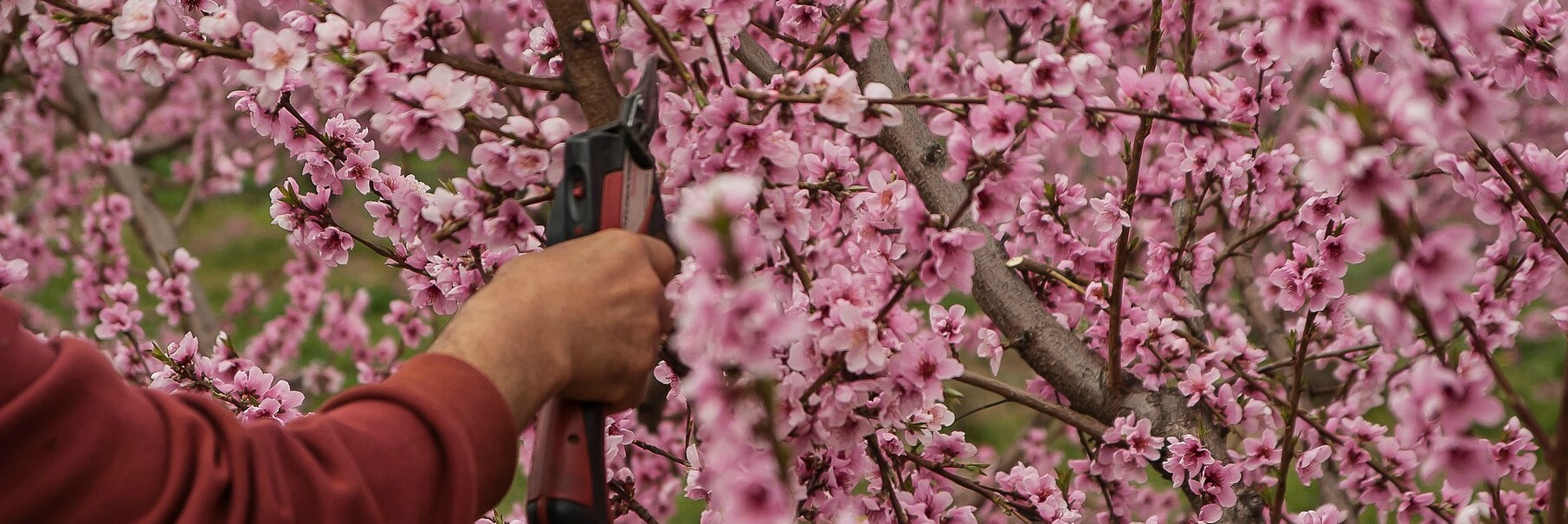
Growing fruit is incredibly rewarding, as long as your trees or bushes are productive – but how do you get the best out of them? We have produced this guides with all the tips and tricks you need for the following fruits (click to jump to section)
Unlike many plant groups that you can care for generally, each fruit requires different treatment to get the best yields. Prune at the wrong time and you could be cutting off your crops or laying them open to disease.
At the very least, feed them well in spring, mulch and water during drought.
Apples & Pears
Apples and pears are generally easy to care for, although correct pruning is essential for the formation of flower buds.
Plants should be pruned every year to get the best crop, generally in summer for espalier, bushes, fans and pyramids and summer and winter for trees. The aim of pruning is to increase flower bud formation and restrict excessive growth. However, prune too hard and you’ll encourage excessive growth of water shoots, which bear no fruit buds, so never remove more than a quarter of the canopy in one season.

Feed trees in early spring with a balanced general fertiliser (such as Growmore) at 100g per square metre. It’s important not to overfeed, as a condition called bitter pit can occur – keep feeding and watering steady during the growing season.
Apples and pears thrive in a sunny, sheltered site, away from any frost pockets and poorly-drained or shallow soils.
Biennial bearing, or trees having a huge crop one year and next to nothing the next, can be a problem. It can be triggered by excessive feeding one year, or frost/drought killing off all blooms, so the plant has extra energy to form fruit buds for the next year. Once it has happened, it’s often hard to regulate the tree’s fruiting mechanism. However, try to avoid too much fertiliser, water regularly during dry spells, mulch and clear away competing plants and weeds.
Shop our selection of 150+ Apple Trees
Shop our selection of 40+ Pear Trees
Apricots
Apricots are a stone fruit, part of the Prunus family, which includes cherries, plums, nectarines, almonds and hybrids. Where other fruit trees are improved by winter pruning, avoid cutting them back then, as the tree can become infected by silver leaf disease. Members of the Prunus family don’t need much pruning but if you must cut a tree back, do it from the end of July to the end of August.
Apricot blossom forms very early in the season and can be ruined by frost. Plant them away from the morning sun (avoid east-facing) – this will destroy flowers. If a series of heavy frosts is forecast, cover the tree with fleece supported by canes so it doesn’t touch the tree but remove it during the day so insects can pollinate the flowers.
You can hand-pollinate for a bigger yield, using a soft artist’s paintbrush or cotton bud. Midday on a dry, sunny day is ideal, preferably for a few days in a row. Afterwards, mist the tree with water – the flowers should be dry by nightfall.
Apricots often set bigger crops than they can support and naturally shed some. However, to enable the fruit to develop to their full size and flavour, thin to about 8-10cm apart when they are the size of hazelnuts – remove any defective fruit first.
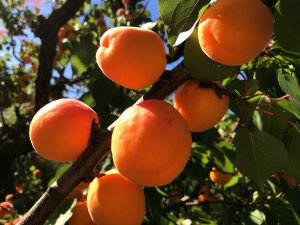
In late February, feed with a general granular fertiliser such as Growmore at 70g per square metre, then mulch with a 5cm layer of well-rotted manure or compost, in March or early April.
Apricots are susceptible to drought, especially when newly-planted – they will drop their fruit in protest. Water frequently in the first spring and summer, and established trees may need watering when the fruit starts to swell.
Shop our selection of 20+ Apricot Trees
Blackberries
Blackberries and related hybrid berries (such as Tayberries) are an easy choice for beginners to achieve a successful crop. Thornless, compact varieties are attractive enough to be grown over obelisks in the flower border, as they have great autumn foliage colour.
Although, they will fruit in light shade, blackberries will bear the largest yields in a sunny, sheltered site, on moisture-retentive, but free-draining soil. On chalky, sandy, or heavy clay, add bulky organic matter.
After planting, cut down all canes to a healthy bud to encourage vigorous, healthy shoots. Regularly tie in these shoots to the plant’s support.
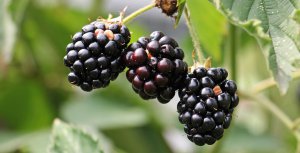
Top-dress blackberries with 100g per square metre of general-purpose fertiliser (such as Growmore) in mid-spring. Cover with a 7cm mulch of well-rotted manure or compost but keep this clear of the crown to prevent new canes rotting.
Young plants will need watering every 7-10 days, after planting and during fruit formation, unless the weather is wet. Established plants shouldn’t need watering unless the summer is very dry, when a good drenching every 10-14 days will help fruit size.
Birds can wreck a crop, so it’s best to net canes to keep them off.
Shop our selection of 15+ Blackberry Bushes
Blueberries
Blueberries are tricky to grow well if you have alkaline soil. They’re lime haters and need an acid soil of pH 5.5 or lower to remain healthy. Even if your soil is on the acid side, check the pH each spring and add sulphur chips if it needs lowering.
If your soil has a higher pH (check with a pH test kit or meter), it’s best to grow blueberries in containers using ericaceous compost. Pick one that is at least 30cm wide initially, moving up eventually to a 50cm pot.
Blueberries need moist compost, but not soaking, and don’t tolerate drought well, so don’t let them dry out. Water with rainwater, not tap water, unless you have no alternative (this will raise the pH level).
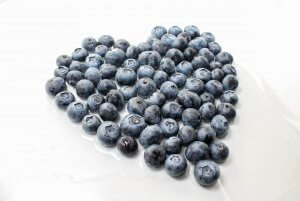
Choose your varieties with care – some are self-fertile, some need a different type of blueberry to bear fruit – even self-fertile types will give heavier crops with another bush nearby.
Plant in a sunny, sheltered spot for the biggest crops – while tolerant of shade, your yield will suffer. Add bulky, acidic organic matter to the planting hole, such as pine needles or composted conifer clippings – avoid farmyard manure.
Once the basics are right, boost yields by feeding container plants every month during the growing season using an ericaceous liquid fertiliser or add slow-release fertiliser in spring (again for lime-hating plants).
After the first couple of years, plants should be pruned in late winter, removing a small amount of old wood to encourage new growth.
Birds can decimate crops, so cover bushes with netting or fleece.
Shop our selection of 20+ Blueberry Bushes
Cherry
Cherries are part of the Prunus family, which includes plums, apricots, nectarines, almonds and hybrids. Where other fruit trees are improved by winter pruning, avoid cutting them back at all costs, as the tree can become infected by silver leaf disease. Members of the Prunus family don’t need much pruning (make sure to choose one on a dwarfing rootstock) but if you must cut a tree back, do it in midsummer.
Many cherries are self-fertile and will fruit happily on their own but the yield will be even better if a different variety is planted nearby so bees, etc, can increase the chance of cross-pollination.
A common problem is that their early blossom is ruined by frost. You can solve this problem by planting trees where they don’t get the morning sun (avoid east-facing) – this will destroy flowers. If a series of heavy frosts is forecast, cover the tree with fleece but remove it during the day so insects can pollinate the flowers.
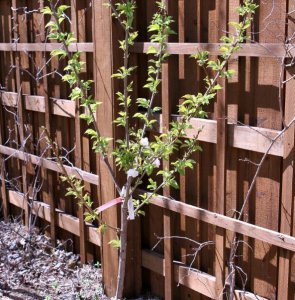
Cherries like deep, fertile and well-drained soil – avoid if your garden has shallow, sandy or badly-drained soil. However, some varieties are suitable for growing in a large container.
Feeding cherries is very important – start with a mulch of well-rotted compost or manure in late February, followed by a granular all-purpose fertiliser like Growmore in March at a rate of 100g per square metre. If fruiting was poor last year, add sulphate of potash at 15g per square metre at the same time. Top up the general fertiliser in mid-spring and keep well watered during fruit formation – drought or waterlogging can cause fruit to drop.
Finally, birds are very keen on cherries – you can net smaller trees or cordons but it may be impractical to cover a large tree.
Shop our selection of 60+ Cherry Trees
Figs
Figs can be grown outdoors in the UK but only successfully in milder regions. It’s better to grow them in large containers and move them to a sunny location outside after overwintering indoor once all danger of frost is past.
Figs are unusual, as flowers develop from fruitlets, which plants can produce from spring to late summer. Only the pea-sized fruitlets produced in late summer survive winter and are advanced enough to flower the next summer. However, fruitlets produced in spring may ripen in greenhouses, giving two crops a year.
To fruit well, figs like to have compact roots, which is why they perform well in pots – start in 30cm containers, repotting every other year, using a pot 5cm larger each time. If you are planting outside, line the planting hole with concrete slabs or similar to restrict root growth. Every other year, dig around the outside of the slabs to trim roots.
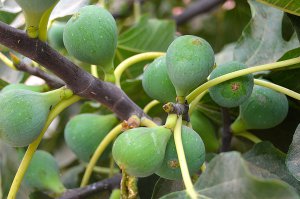
For the best yields, in spring, apply a general-purpose granular feed (such as Growmore) and mulch with well-rotted manure or compost.
Once you see young figs, feed plants with liquid tomato fertiliser every two or three weeks, until they start to ripen. Figs also require lots of water during summer but make sure it is free draining – they don’t like to sit in water.
To save the plant’s energy, remove larger fruits that are not mature enough to ripen at the end of the season, leaving the tiny embryo fruits at the shoot tips for the following year.
Shop our selection of 20+ Fig Trees
Grapes
Grapes require patience – and knowledge – to fruit correctly but by following some basic rules, you can enjoy growing your own bunches.
Firstly, consider where you live. While it’s quite possible to get a decent crop on good garden soil in a sunny spot in southern Britain, your best bet further north (or at altitude) is to grow under glass.
Dessert grapes need to be grown in a greenhouse to ripen properly, while wine varieties are hardier, ripening on a sheltered, sunny, south- or southwest-facing wall or fence.
Grapevines grow on any soil, as long as it is relatively deep and well drained. Once established, outdoor vines are relatively drought-tolerant but will need watering in their first year.
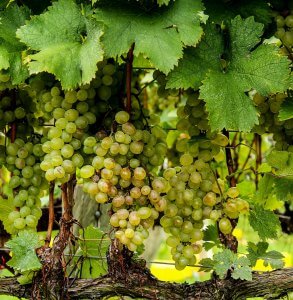
Mulch with 5-7cm of gravel in spring – don’t use manure. During the growing season, water well and feed with a liquid tomato fertiliser.
Pruning correctly is vital for high yields and here’s where the patience comes in. Remove all flowers for the first two years after planting, then allow just three bunches on three-year-old vines. A four-year-old will support about five bunches – allow full cropping from the fifth year.
Indoors, pollination needs a dry atmosphere and gently shaking branches helps. One the grapes are forming, use special grape-thinning scissors to thin the bunches, which will improve ripening, although outdoor wine grapes don’t need this.
Shop our selection of 20+ Grape Vines
Plums
Plums, gages and damsons are part of the Prunus family, which includes cherries, apricots, nectarines, almonds and hybrids. Where other fruit trees are improved by winter pruning, avoid cutting them back at this time, as the tree can become infected by silver leaf disease. Members of the Prunus family don’t need much pruning (make sure to choose one on a dwarfing rootstock) but if you must cut a tree back, do it in midsummer and make pruning cuts as small as possible.
Some plum varieties can bear huge crops one year, followed by much smaller yields the next – basically, the tree exhausts itself and needs to build up its strength.
Increase yearly yields by watering and feeding at the right times. On established trees, top-dress with sulphate of potash in February. In mid-spring, mulch with well-rotted manure or compost to retain soil moisture and provide much-needed nitrogen. For an extra boost, add a top-dressing of organic dried poultry manure pellets or non-organic sulphate of ammonia.
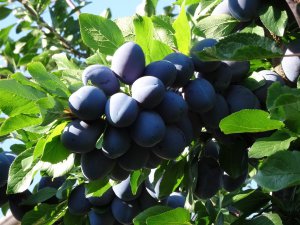
Plums are one of the earliest flowering of the stone fruits and their early blossom can be ruined by frost. You can solve this problem by planting them where they don’t get the morning sun (avoid east-facing) – this will destroy flowers. If a series of heavy frosts is forecast, cover the tree with fleece but remove it during the day so insects can pollinate the flowers.
Plums require a lot of water so like loamy or clay soils but hate being waterlogged – add lots of bulky organic matter if you have shallow or sandy soil. If growing in a container, make sure it is large enough so the tree isn’t short of water.
Shop our selection of 70+ Plum Trees
Raspberries
Raspberries are an easy-to-grow cane fruit, fruiting either in summer or autumn.
They love moisture-retentive, fertile, slightly acidic soils, which are well-drained. Avoid waterlogged and chalky soils.
The canes do best in a sheltered, sunny position – they will tolerate part shade. Raspberries are self-fertile and pollinated by insects, so avoid a windy site.
Yields depend very much on pruning. For summer-fruiting raspberries, cut back fruited canes to ground level after harvesting. Choose six to eight strong canes per plant, and remove the rest at ground level.
Autumn-fruiting raspberries are even easier – simply cut back all canes to ground level in February, reducing the number in summer if they are overcrowded.
In mid-spring, sprinkle a granular fertiliser (such as Growmore or blood, fish and bone) around plants at 35g per square metre, then add a mulch of garden compost – avoid mushroom compost or very rich manure as it may burn new shoots. If last year’s crop was poor, add dried poultry manure pellets at 100 per square metre.
Feed monthly with a liquid general-purpose fertiliser during the growing season.
Shop our selection of 30+ Raspberry Bushes
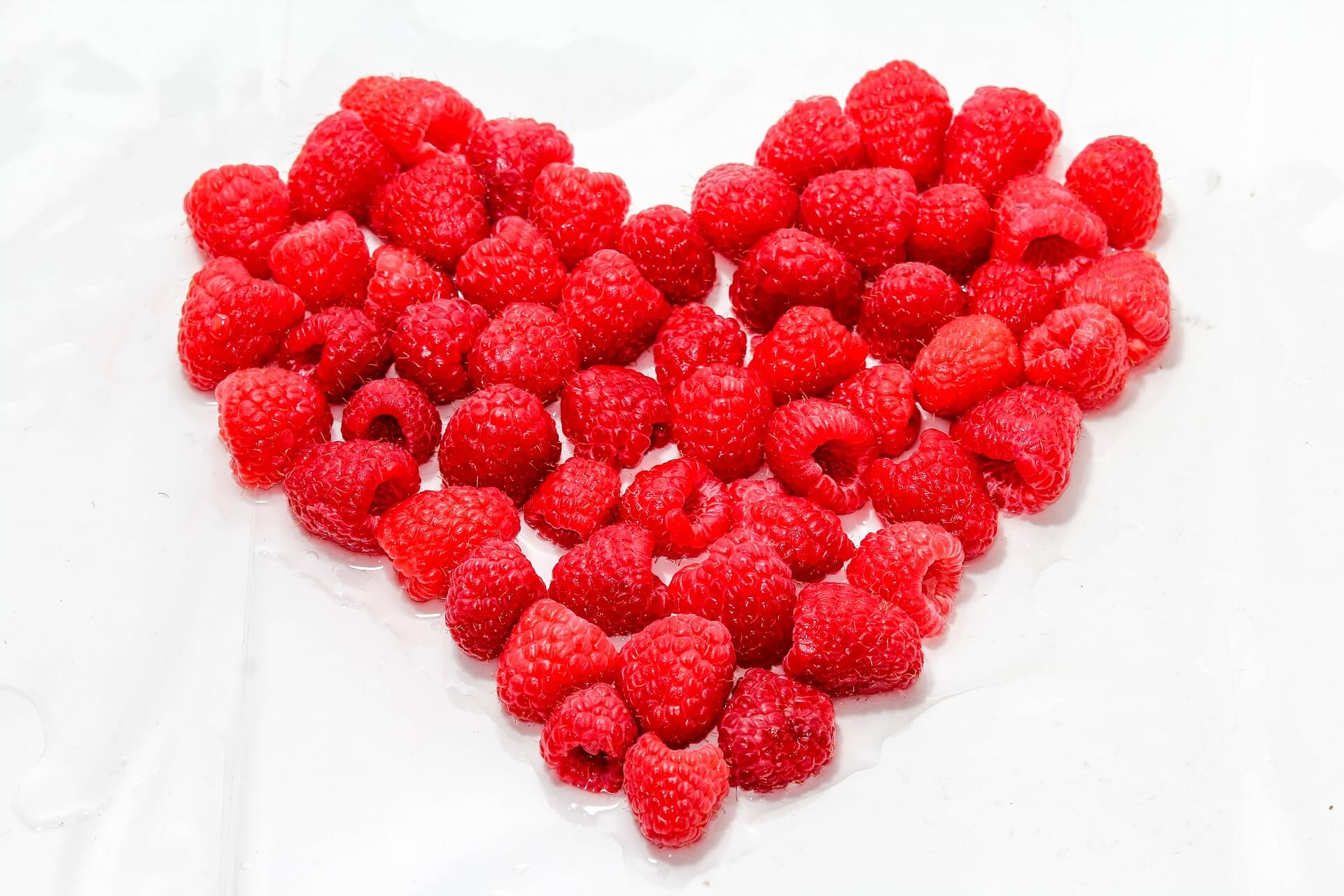
–
Alex works in the Primrose buying team, sourcing exciting new varieties of plants.
As a psychology graduate it is ironic that he understands plants better than people but a benefit for the purpose of writing this blog.
An enthusiastic gardener, all he needs now is a garden and he’ll be on the path to greatness. Alex’s special talents include superior planter knowledge and the ability to put a gardening twist on any current affairs story.